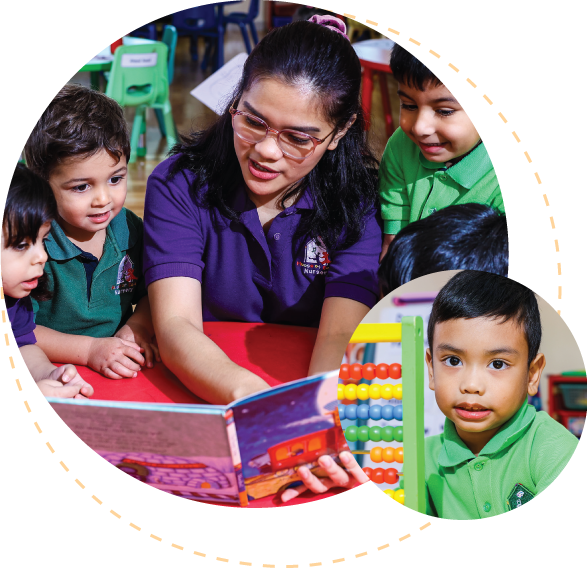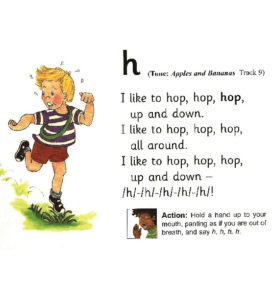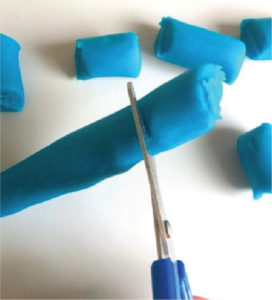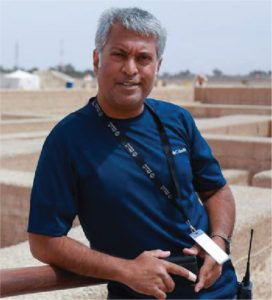
Eiusmod tempor incididunt ut labore et dolore magna aliqua. Quis ipsum ultrice gravida isus commodo viverra.
- Mon - Thu: 7:00am – 2:00pm / 4:45pm Fri: 7:00am – 11:15pm / 1:30pm
- +971 3 761 2204
- 10th Street, Falaj Hazza, Al Ain, UAE

Eiusmod tempor incididunt ut labore et dolore magna aliqua. Quis ipsum ultrice gravida isus commodo viverra.

The Early Years Foundation stage is the early years curriculum guidance, that we follow to support your children develop in all areas.
The following 4 themes underpin all the guidance:
The Unique Child: every child is unique who is constantly learning, capable confident and self-assured
Positive Relationships: Children learn to be strong and independent
Enabling Environment: Children learn and develop best in an enabling environment where their experiences respond to their individual needs and where there’s a strong partnership between practitioners, parents and carers.
Learning and Development: Children develop and learn in different ways. The Framework covers the education and care of all children in early year’s provision, including children with special educational needs and disabilities.


The Characteristics of Effective Learning and the Prime and Specific areas of learning and development are all interconnected. This is the way a child engages with other people and their environment – and it underpins all aspects of learning and development across all areas and support the child to remain an effective and motivated learner.
Characteristics of Effective Learning
These are the fundamental building blocks which support all other areas of development and include
1. Personal, Social and Emotional Development:
Children’s personal, social and emotional development (PSED) is crucial for children to lead healthy and happy lives, and is fundamental to their cognitive development. Underpinning their personal development are the important attachments that shape their social world. Strong, warm and supportive relationships with adults enable children to learn how to understand their own feelings and those of others.
Through supportive and warm relationships, practitioners can help to support children with managing their emotions and developing a positive sense of self, encourage them to have confidence in their own abilities. Children are encouraged to persist when activities are challenging and to develop the patience needed in order to wait for what they want.
Additionally includes practitioners helping children to gain an understanding of how to keep their bodies healthy, including healthy eating, and to help support them with managing their personal needs so that they can do this independently over time.
Friendships with other children form another important aspect of PSED with practitioners needing to help EYFS children with their interactions and provide them with the skills that they need in order to resolve conflicts effectively.
2. Communication and Language
Children’s back-and-forth interactions from an early age form the foundations for language and cognitive development.’
With this in mind, the statutory framework for the EYFS recognizes that a critical element of communication and language development is the interactions and conversations children have with practitioners and peers within a ‘language-rich environment’. It’s important that these conversations are both high quality and frequently occurring. Our teachers are trained to ask Open-ended questions like
How can we find out? What made you think of that? Why do you think that happened? What could you change? Instead of close-ended questions like what is this? Where do you get this?
3. Physical Development
Physical development consists of two elements: Gross Motor Skills and Fine Motor Skills. The statutory framework for the early year’s foundation stage states that:
‘Gross motor skills provide the foundation for developing healthy bodies and social and emotional well-being. Fine motor control and precision helps with hand-eye co-ordination, which is later linked to early literacy.’
During early years, it’s important to provide activities that support children’s gross motor development, both indoors and out. This will additionally help to develop children’s core strength; an important factor to successfully developing effective gross motor skills.
Whilst gross motor development involves larger body movements, fine motor development involves the smaller, more precise movements of the hands, wrists, and fingers. Fine motor skills are needed for activities, such as fastening buttons, writing skills and effectively cutting with scissors.
These include essential skills and knowledge which enable children to participate successfully in society.
These develop effectively when the Prime areas are thoroughly embedded.
1. Numeracy:
The early learning goals for mathematics.
At the end of the reception year, children are assessed against the early learning goals (ELGs). There are two elements for the mathematics ELGs, number and numerical pattern. The mathematics ELGs are as follows:
ELG: Number
Children at the expected level of development will:
ELG: Numerical Patterns
Children at the expected level of development will:
The stages of learning early numeracy concepts are: emergent, perceptual, figurative, counting on and facile.
Emergent:
Perceptual:
• Are able to count collections of objects they can see, touch or feel.
Figurative Stage:
Counting On stage:
2. Literacy:
As the earliest stage of literacy development, emergent literacy is the first moment that a child begins to understand letters and words. At this stage Emerging Learners
Jolly Phonics: In order to support emerging readers by helping them understand alphabet knowledge and phonological awareness House of Colours Nursery introduces the letters through the much acclaimed Jolly Phonics.
Children start off by recognizing that print holds meaning. Though they can’t decode the printed words, they retell stories in their own words as they turn the pages of their little books. They comment on the illustrations and discuss what they like or notice in the stories.
The students are developing some phonemic awareness skills, including the ability to rhyme and use alliteration. They recognize some common words in environmental print, like the names of their favorite restaurants. Some students in the class are beginning to recognize printed letters and identify their related sounds.
Techniques used during read- aloud: During a read-aloud, the teacher holds the book upright and points out the author and illustrator. She models how to turn the pages, and she points to each word as she reads, showing the one-to-one correspondence between the written and spoken word. To model reading from left to right, she follows along with her finger, moving to the sentence below when she reaches the end of each line.
She engages in word play frequently, reads poems and nursery rhymes, and asks students to form rhyming pairs. She asks what sounds students hear at the beginning and ending of a word, and she begins introducing them to letter names and sounds.

Pre-Writing and writing Skills:
Pre-writing skills are the fundamental fine motor skills that children need to develop before they begin to write. Pre-writing skills help your child build finger strength, eye hand coordination, wrist movement and grip strength.
At House of Colours Nursery mark making and prewriting skills are developed through play way method:
Playdough, Cutting patterns, Water paint, Scoop and pour, Ball throwing games, Squishy bags, Bubble wrap etc.

Expected Child Milestones for pre-writing
1-2 years
Imitate a vertical line
Scribble in a vertical or horizontal motion
2-3 years
Imitate/Master a horizontal line
Imitate/ Master a vertical line
Imitate a circle shape
3-4 years
Master horizontal and vertical lines.
Imitate the shapes of circle and square and cross shapes (+)
3. Understanding the World
It involves guiding children to make sense of their physical world and their community.
The frequency and range of children’s personal experiences increases their knowledge and sense of the world around them – from visiting parks, libraries and museums to meeting important members of society such as police officers, nurses and firefighters.
In addition, listening to a broad selection of stories, non-fiction, rhymes and poems will foster their understanding of our culturally, socially, technologically and ecologically diverse world. As well as building important knowledge, this extends their familiarity with words that support understanding across domains. Enriching and widening children’s vocabulary will support later reading comprehension.
Encouraging Emarati Identity: Kandura, abayah, Dallah, coffee, dates, camel milk, harees, fouga, kabsa and luqemat. All that denotes and represents the identity and leadership of this country is an active part of inclusion in our curriculum. Sheikh Zayed’s vision of making this country number one in everything is paramount in House of Colours Nursery vision.
Following this vision House of Colours Nursery have teamed up with Ajmal Hassan an Environment Specialist in Mleiha Archeological Center to incorporate Emarati Flora and Fauna in its curricula. Instagram: ajmal.hasan

4. Expressive Arts and Design
Expressive arts and design encompasses a wide breadth of creative areas, such as listening and responding to singing and performing, experimenting with colour mixing and different textures, creating models (for example, junk modelling), small world play, building and construction, and role-play activities.
Children taking part in expressive arts and design activities in early year’s settings gain many valuable skills as these types of activities help to support children’s creativity and imagination, allows children to explore different materials, media and sounds, as well as helping to build children’s confidence in their own ideas and opinions.
Testimonials are a way for our parents to express their feelings and appreciation towards our Nursery, please read some of our parent testimonials.
I have seen remarkable progress in Keyan since he started attending House of Colours Nursery. The exceptional care provided by the staff has played a significant role in his positive experience. The girls in his room are fantastic, and I am grateful for the attentive and nurturing environment they create. The principal has been amazing and easy to communicate with, ensuring a smooth experience for both Keyan and me. Seeing Keyan's radiant smile is priceless, and the staff's ability to consistently bring joy to his face is remarkable. I am sincerely thankful for their dedication and impact on Keyan's development.
I would like to express my heartiest gratitude and well wishes to the teacher for making my child's first experience away from home a wonderful one. Nahyan loves you and you will be remebered as his first teacher who taught him his first letters. Thank you miss Leah and miss Jabeen for your kindness and care that made him come to the nursery everyday with eagerness. Let me extend my wishes to the House of Colours Nursery and all of its staffs for their efforts. Thank you and Nahyan will miss you.